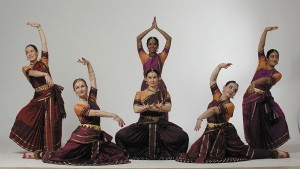RADHA ANJALI – BHARATANATYAM

Verein für indische Kunst & Kultur in Wien
“yato hastas tato drstir, yato drstis tato manah, yato manas tato bhavo,yato bhavas tato rasah“ – Abhinayadarpana, Vers 37, Nandikesvara . Wo die Hände sind/sich hinbewegen dort ist der Blick, wo der Blick ist, ist der Geist,wo der Geist ist, ist das Gefühl, wo das Gefühl ist, ist (entsteht) Rasa.
Bharatanatyam (Tamil: பரதநாட்டியம்) is a classical Indian dance form originating in Tamil Nadu[1][2][3][4][5], now in India. This dance form denotes various 19th and 20th century reconstructions of Cathir, the art of temple dancers. Cathir in turn, is derived from ancient dance forms. Bharatanatyam is usually accompanied by the classical music. It has its inspirations from the sculptures of the ancient temple of Chidambaram. Bharatanatyam, as the name depicts is the combination of:
BHA- Bhava (Expression), RA- Raga (Music) and TA- Tala (Rhythm) Bharatanatyam is a traditional dance-form known for its grace, purity, tenderness, and sculpturesque poses. Today, it is one of the most popular and widely performed dance styles and is practiced by male and female dancers all over India.
Usefull Links & Information:
-
Bharatanatyam, Laya-Yoga & Meditation by Dr. phil. Angela-Petra Saber-Zaimian (Radha Anjali) : > Körperlichkeit & indische Philosophie in (laya) Yoga & Bharatanatyam <
-
Alexandra Romanova was trained in ballet at the National School of Ballet in Warsaw, studied indology at Warsaw University and was awarded scholarship to learn Bharata Natyam dance in India. She spent years being trained by Yamini Krishnamurti, in New Delhi. www.alexromanova.com
> Dein Ayurveda Net….. > Bharatanatyam <
> Meet Bharatanatyam Group at facebook <
Comments are closed.